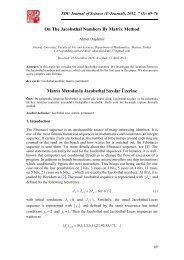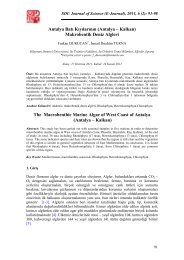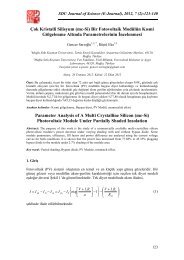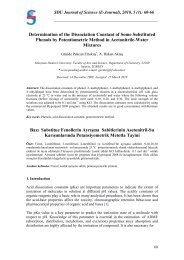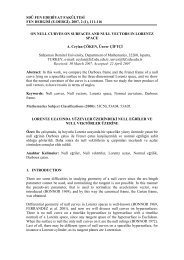Interstitial and Phytal Harpacticoida (Crustacea: Copepoda ...
Interstitial and Phytal Harpacticoida (Crustacea: Copepoda ...
Interstitial and Phytal Harpacticoida (Crustacea: Copepoda ...
You also want an ePaper? Increase the reach of your titles
YUMPU automatically turns print PDFs into web optimized ePapers that Google loves.
SDU Journal of Science (E-Journal), 2010, 5 (1): 16-28___________________________________________________________________<strong>Interstitial</strong> <strong>and</strong> <strong>Phytal</strong> <strong>Harpacticoida</strong> (<strong>Crustacea</strong>: <strong>Copepoda</strong>)inhabiting the Mediolittoral Zone of the Datça-BozburunPeninsulas (Muğla, Turkey)Alp Alper 1 , Süphan Karaytuğ 2,* , Serdar Sak 11 Balıkesir University, Faculty of Arts <strong>and</strong> Science, Department of Biology, 10145, Balıkesir, TURKEY2 Mersin University, Faculty of Arts <strong>and</strong> Science, Department of Biology, 33343, Mersin, TURKEY* corresponding author e-mail: suphankaraytug@gmail.comReceived: 18 February 2010, Accepted:27 March 2010Abstract: Harpacticoid copepods inhabiting interstitial <strong>and</strong> phytal habitats in the mediolittoral zone ofs<strong>and</strong>y beaches of the Datça–Bozburun Specially Protected Area were investigated. Examination of thesamples revealed 49 species belonging to 41 genera in 17 families. All taxa identified were recorded forthe first time from the study area. Comparison with published marine harpacticoid records from Turkeyalso revealed that 4 families, 15 genera <strong>and</strong> 34 species had not previously been reported from Turkishwaters. In terms of species richness, the family Miraciiidae ranked first with 9 species, followed byLaophontidae with 7 species, Ectinosomatidae with 5 species, Ameiridae, Thalestridae <strong>and</strong> Tisbidae with4 species, Paramesochridae with 3 species, Arenopontiidae, Canthocamptidae <strong>and</strong> Harpacticidae with 2species, Cletotidae, Idyanthidae, Latiremidae, Leptastacidae, Louriniidae, Tegastidae <strong>and</strong>Parastenheliidae with 1 species.Key words: Taxonomy, Fauna, new record.Datça-Bozburun Yarımadalarının (Muğla, Turkiye) MediolittoralBölgesinde Kumiçi ve Fital Yaşayan <strong>Harpacticoida</strong> (<strong>Crustacea</strong>:<strong>Copepoda</strong>) TürleriÖzet: Datça–Bozburun Özel Çevre Koruma bölgesi sahillerinde (mediolittoral bölgede) kumiçi ve fitalyaşayan harpaktikoid kopepodları araştırıldı. Toplanan örneklerin incelenmesi sonucunda 17 familyayaait 41 cins içerisinde 49 tür belirlenmiştir. Teşhis edilen tüm taksonlar çalışma alanından ilk defa kaytedilmektedir. Türkiye’den bildirilmiş denizel harpaktikoit kopepod kayıtları incelendiğinde 4 familya, 15cins ve 34 türün daha önce Türkiye denizlerinden kayıt edilmediği belirlendi. Tür sayısı bakımındanMiraciidae familyası (9 tür) ilk sırada yer alırken bu familyayı 7 tür ile Laophontidae, 5 tür ileEctinosomatidae, 4 tür ile Ameiridae, Thalestridae ve Tisbidae, 3 tür ile Paramesochridae, 2 tür ileArenopontiidae ve Canthocamptidae, Harpacticidae, 1 tür ile Cletotidae, Idyanthidae, Latiremidae,Leptastacidae, Louriniidae, Parastenhaliidae ve Tegastidae familyaları takip etmiştir.Anahtar kelimeler: Taksonomi, Fauna, yeni kayıt.1. IntroductionThe order <strong>Harpacticoida</strong> contains over 4,300 species belonging to 589 genera <strong>and</strong> 56families [1]. They inhabit almost all aquatic environments from the hadal zone [2] tointertidal rock pools above the level of mean high tide [3] in the seas, <strong>and</strong> fromcontinental groundwater [4] to water bodies in the Himalayan Mountains [5] infreshwater environments. They are the second most abundant group after nematodes inbenthic meiofaunal communities [6]. The marine harpacticoid fauna of the Turkey ispoorly known despite the fact that the country has a vast coastline of about 8,300kilometres. Noodt [7] was the first to contribute to the marine Turkish harpacticoid16
A. Alper, S. Karaytuğ, S. Sakfauna by reporting 52 species <strong>and</strong> subspecies from the Sea of Marmara. Later recordsadded to the Turkish fauna between 1955-2006 were summarized by Karaytuğ <strong>and</strong> Sak[8]. Recently Psammoleptastacus barani Sak, Huys & Karaytuğ, 2008 from the TurkishBlack Sea coast [9] <strong>and</strong> Ciplakastacus mersinensis Sak, Karaytuğ & Huys, 2008 fromthe Turkish Mediterranean Coast [10] were described as new to science. Finally Sak etal. [11] reported <strong>and</strong> redescribed Pseudoleptomesochrella halophila based on thematerial collected from the s<strong>and</strong>y beaches of Kurucaşile (Bartın) <strong>and</strong> Doğanyurt(Kastamonu). However, harpacticoids of the majority of the Turkish coastline are stillnot known. Here we contribute to the knowledge of the copepod biodiversity in Turkeyby reporting the first data on the interstitial <strong>and</strong> phytal <strong>Harpacticoida</strong> of Datça <strong>and</strong>Bozburun peninsulas.2. Material <strong>and</strong> MethodThe Datça-Bozburun Peninsulas is one of the most important specially protected areasin Turkey. The size of the area is 1,474 km 2 , encompassing two peninsulas (Figure 1).Samples were collected from 22 stations (Table 1) between April 2007 <strong>and</strong> February2008. <strong>Interstitial</strong> samples were taken according to the Karaman-Chauppuis method [12].Stations 1-16 were located at Datça Peninsula, 17-22 were located at BozburunPeninsula (Figure 1, Table 1). <strong>Phytal</strong> samples were taken from the supralittoral rockyshores by h<strong>and</strong>. All samples were immediately preserved with 4% formalin solution.Copepods were extracted from detritus under an OLYMPUS SZX-12 stereomicroscope<strong>and</strong> stored in 70% ethanol. Selected specimens were dissected in lactic acid <strong>and</strong> theparts mounted on slides in lactophenol mounting medium. Glass fibres were added toprevent the animal <strong>and</strong> appendages from being compressed by the coverslip <strong>and</strong> tofacilitate rotation <strong>and</strong> manipulation, allowing observation from all angles. Preparationswere subsequently sealed with Entellan. Identifications were made under an OLYMPUSBX 50 microscope equipped with differential interference contrast (DIC). Specimenswere identified according to Wells [1], Huys et al. [13] <strong>and</strong> relevant other literature.Figure 1. Map of the study area <strong>and</strong> the sampling stations17
A. Alper, S. Karaytuğ, S. Sakwashings of the macroalgae Cystoseira sp., Corallina sp., Halopteris sp., Bangia sp.,Polysiphonia sp. <strong>and</strong> Padina pavonica (Linnaeus, 1758).Distribution in Turkey: Sea of Marmara [7, 8].Amonardia perturbata Lang, 1965Material examined: St.19 (6♀♀), 16.04.2007. In washings of the macroalgaeCystoseira sp. <strong>and</strong> Corallina sp.Distribution in Turkey: Sea of Marmara [8].Paramphiascella mediterranea Lang, 1948Material examined: St.19 (1♀), 23.02.2008. In washings of the macroalgae Cystoseirasp. <strong>and</strong> Padina pavonica.Distribution in Turkey: new record.Amphiascopsis cinctus (Claus, 1866)Material examined: St.1 (3♀♀, 2♂♂), St.2 (9♀♀, 4♂♂), 15.04.2007; St.7 (4♀♀, 1♂),St.15 (5♀♀), 16.04.2007; St.1 (4♀♀), St. 2 (7♀♀, 2♂♂), 21.08.2007; St.1 (4♀♀,3♂♂), St.2 (5♀♀, 1♂), 04.12.2007; St.1 (1♀, 1♂), St.2 (5♀♀, 2♂♂), 25.02.2008. Inwashings of the macroalgae Cystoseira sp., Corallina sp., Halopteris sp., <strong>and</strong> Padinapavonica.Distribution in Turkey: Sea of Marmara [8].Delavalia oblonga (Lang, 1965)Material examined: St.7 (1♀), 16.04. 2007. In washings of the macroalgae Cystoseirasp., Corallina sp., Halopteris sp.Distribution in Turkey: new record.Schizopera brusinae Petkovski, 1954Material examined: St.7 (2♀♀, 1♂), 16.04.2007. In washings of the macroalgaeCorallina sp., Cystoseira sp., Halopteris sp.Distribution in Turkey: Sea of Marmara [8].Pseudamphiascopsis attenuatus (Sars, 1906)Material examined: St.2 (1♀), 25.02.2008. In washings of the macroalgae Corallinasp. <strong>and</strong> Cystoseira sp.Distribution in Turkey: Sea of Marmara [7].Macrosetella gracilis (Dana, 1847)Material examined: St.11 (2♀♀, 1♂), St.19 (1♀), 16.04.2007. Found in intersititalsample.Distribution in Turkey: new record.Family: LAOPHONTIDAE T. Scott, 1905Klieonychocamptus kliei adriaticus (Petkovski, 1954)Material examined: St.1 (6♀♀, 1♂), St.2 (6♀♀, 2♂♂), St.4 (4♀♀, 1♂), 15.04.2007;St.7 (2♀♀, 1♂), 16.04.2007; St.1 (4♀♀, 2♂♂), St.2 (7♀♀, 3♂♂), St.4 (4♀♀, 3♂♂),21.08.2007; St.7 (3♀♀, 4♂♂), 20.08.2007; St.1 (2♀♀, 1♂), St.2 (3♀♀), St.4 (2♀♀,19
SDU Journal of Science (E-Journal), 2010, 5 (1): 16-28___________________________________________________________________2♂♂), 04.12.2007; St.1 (5♀♀, 2♂♂), St.2 (5♀♀, 2♂♂), St.4 (5♀♀, 5♂♂), 25.02.2008;St.7 (1♀), 26.02.2008; St.15 (4♀♀), 25.02.2008; St.19 (2♀♀), St.20 (4♀♀, 1♂),23.02.2008. In washings of the macroalgae Padina pavonica, Corallina sp., Cystoseirasp., Gelidium sp., Halopteris sp., Laurencia sp. <strong>and</strong> Sphacelaria sp.Distribution in Turkey: new record.Paralaophonte brevirostris (Claus, 1863)Material examined: St.7 (1♀), 16.04.2007; St.7 (2♀♀, 1♀), 20.08.2007; St.5 (1♀),25.02.2008; St.7 (1♀), 26.02.2008. In washings of the macroalgae Cystoseira sp.,Corallina sp., Halopteris sp., Bangia sp. <strong>and</strong> Polysiphonia sp.Distribution in Turkey: Sea of Marmara [8].Paralaophonte quaterspinata (Brian, 1917)Material examined: St.2 (5♀♀), 21.08.2007; St.2 (2♀♀, 1♂), 04.12.2007; St.2 (2♀♀,1♂), 25.02.2008. In washings of the macroalgae Cystoseira sp. <strong>and</strong> Corallina sp.Distribution in Turkey: new recordAfrolaophonte pori Masry, 1970Material examined: St.6 (3♀♀, 3♂♂), 15.04.2007; St.7 (3♀♀, 3♂♂), St.15 (5♀♀,2♂♂), 16.04.2007; St.6 (1♀, 1♂), 21.08.2007; St.7 (2♀♀, 2♂♂), 20.08.2007; St.15(4♀♀, 1♂), 21.08.2007; St.8 (5♀♀, 6♂♂), St.15 (4♀♀, 1♂), 04.12.2007; St.7 (4♀♀),St.8 (10♀♀, 5♂♂), 26.02.2008; St.15 (2♂♂), 25.02.2008. In washings of themacroalgae Cystoseira sp., Corallina sp., Enteromorpha sp., Halopteris sp., Bangia sp.<strong>and</strong> Polysiphonia sp.Distribution in Turkey: new record.Heterolaophonte stroemii (Baird, 1837)Material examined: St.6 (3♀♀, 1♂), 15.04.2007; St.11 (3♀♀, 3♂♂), St.12 (3♀♀,1♂), 16.04.2007; St.6 (4♀♀, 1♂), St.11 (6♀♀, 4♂♂), 21.08.2007; St.6 (3♀♀, 1♂),St.11 (3♀♀, 4♂♂), 04.12.2007; St.6 (2♀♀, 2♂♂), 25.02.2008; St.11 (7♀♀, 1♂),23.02.2008. In washings of the macroalgae Cystoseira sp., Corallina sp., Halopteris sp.,Laurencia sp. <strong>and</strong> Enteromorpha sp.Distribution in Turkey: Sea of Marmara [8].Heterolaophonte uncinata (Czerniavski, 1868)Material examined: St.8 (1♀), St.10 (3♀♀, 1♂), 16.04.2007; St. 5 (3♀♀, 1♂),21.08.2007; St.8 (4♀♀, 1♂), St.10 (4♀♀), 20.08.2007; St.8 (3♀♀, 3♂♂), St.10 (2♀♀),04.12.2007; St. 5 (2♀♀, 1♂), 25.02.2008; St.10 (6♀♀, 1♂), 26.02.2008. In washings ofthe macroalgae Cystoseira sp., Corallina sp., Halopteris sp., Enteromorpha sp.,Dictyopteris sp., Laurencia sp., Gelidium sp., Sphacelaria sp. <strong>and</strong> Padina pavonica.Distribution in Turkey: new record.Loureirophonte cesareae (Por, 1964)Material examined: St.14 (1♂), 25.02.2008. Found in interstitial sample.Distribution in Turkey: new record.20
A. Alper, S. Karaytuğ, S. SakFamily: ECTINOSOMATIDAE Sars, 1903Ectinosoma soyeri Apostolov, 1975Material examined: St.2 (8♀♀, 3♂♂), St.4 (4♀♀, 2♂♂), St.5 (3♀♀, 2♂♂),15.04.2007; St.12 (5♀♀, 2♂♂), 16.04.2007; St.2 (4♀♀, 1♂), St.4 (2♀♀, 2♂♂), St.5(3♀♀, 1♂), St.6 (2♀♀, 1♂), St.12 (4♀♀, 3♂♂), St.13 (3♀♀, 2♂♂), St.14 (2♀♀, 2♂♂),21.08.2007; St.22 (5♀♀, 1♂), 23.08.2007; St.2 (6♀♀, 2♂♂), St.4 (3♀♀, 1♂), St.5(4♀♀, 1♂), St.6 (8♀♀, 3♂), St.12 (6♀♀, ♂♂), St.13 (5♀♀, 1♂), St.14 (4♀♀, 1♂♂),04.12.2007; St.22 (6♀♀), 03.12.2007; St.4 (5♀♀), St.5 (5♀♀, 2♂♂), St.6 (1♀, 1♂),St.12 (4♀♀, 4♂♂), St.13 (2♀♀, 2♂♂), St.14 (8♀♀), 25.02.2008; St.22 (3♀♀),23.02.2008. Found in interstitial sample.Distribution in Turkey: new record.Microsetella norvegica (Boeck, 1865)Material examined: St.5 (2♀♀), 15.04.2007; St.12 (1♀), 16.04.2007; St.3 (2♀♀, 1♂),04.12.2007; St.3 (4♀♀), St.5 (6♀♀), St.6 (4♀♀, 1♂), 25.02.2008; St.7 (2♀♀, 2♂♂),St.9 (1♀, 1♂), St.10 (2♀♀), 26.02.2008; St.11 (2♀♀), 23.02.2008; St.12 (3♀♀), St.15(3♀♀, 1♂), 25.02.2008; St.19 (3♀♀), 23.02.2008. Found in interstitial sample.Distribution in Turkey: new record.Arenosetella tenuissima (Klie, 1929)Material examined: St.10 (2♀♀, 1♂), St.12 (3♀♀), St.14 (2♀♀), 16.04.2007; St.10(3♀♀, 3♂♂); 20.08.2007; St.12 (3♀♀, 2♂♂), 21.08.2007; St.10 (2♀♀, 1♂), St.12(2♀♀, 1♂), 04.12.2007; St.12 (4♀♀, 1♂), 25.02.2008. Found in interstitial sample.Distribution in Turkey: new record.Arenosetella germanica Kunz, 1937Material examined: St.12 (4♀♀, 1♂), 21.08.2007; St.5 (2♀♀, 1♂), St.13 (2♀♀),04.12.2007; St.5 (5♀♀), St.13 (2♀♀, 1♂), 25.02.2008. Found in interstitial sample.Distribution in Turkey: Sea of Marmara [8].Hastigerella bodini Apostolov, 1974Material examined: St.22 (1♀), 23.02.2008. Found in interstitial sample.Distribution in Turkey: new record.Family: THALESTRIDAE Sars, 1905Eudactylopus spectabilis (Brian, 1923)Material examined: St.7 (1♀), 16.04.2007. In washings of the macroalgae Cystoseirasp., Corallina sp. <strong>and</strong> Halopteris sp.Distribution in Turkey: new record.Family: DACTYLOPUSIIDAE Lang, 1936Dactylopusia tisboides (Claus, 1863)Material examined: St.7 (2♀♀), St.19 (2♀♀), 16.04.2007; St.7 (2♀♀, 1♂),20.08.2007; St.19 (3♀♀, 1♂), 23.02.2008. In washings of the macroalgae Cystoseirasp., Corallina sp., Halopteris sp. <strong>and</strong> Padina pavonica.21
SDU Journal of Science (E-Journal), 2010, 5 (1): 16-28Distribution in Turkey: new record.___________________________________________________________________Diarthrodes brevipes Wells <strong>and</strong> Rao, 1987Material examined: St.7 (1♀), St.11 (2♀♀), 16.04.2007; St.7 (2♀♀), 20.08.2007;St.11 (1♀), 21.08.2007; St.11 (3♀♀), 04.12.2007; St.11 (1♀), 23.02.2008. In washingsof the macroalgae Cystoseira sp, Corallina sp., Halopteris sp. <strong>and</strong> Laurencia sp.Distribution in Turkey: new record.Diarthrodes ponticus (Kričagin, 1873)Material examined: St.7 (2♀♀), 16.04.2007. In washings of the macroalgae Cystoseirasp., Corallina sp. <strong>and</strong> Halopteris sp.Distribution in Turkey: new record.Family: TISBIDAE Stebbing, 1910Tisbe angusta (Sars, 1905)Material examined: St.7 (4♀♀), St.15 (2♀♀), 16.04.2007; St.7 (3♀♀), 20.08.2007;St.7 (3♀♀), 26.02.2008. In washings of the macroalgae Cystoseira sp., Corallina sp.,Halopteris sp., Bangia sp. <strong>and</strong> Polysiphonia sp.Distribution in Turkey: new record.Tisbe perplexa Volkmann, 1979Material examined: St.19 (4♀♀, 2♂♂), 16.04.2007; St.19 (2♀♀, 2♂♂), 23.02.2008.In washings of the macroalgae Cystoseira sp. <strong>and</strong> Padina pavonica.Distribution in Turkey: new record.Paraidya occulta Humes <strong>and</strong> Ho, 1969Material examined: St.2 (1♀), 15.04.2007. In washings of the macroalgae Cystoseirasp. <strong>and</strong> Corallina sp.Distribution in Turkey: new record.Scutellidium longicauda (Philippi, 1840)Material examined: St.3 (2♀♀), St.4 (3♀♀, 1♂), 15.04.2007; St.7 (1♀), St.11 (3♀♀,1♂), St.19 (2♀♀, 1♂), 16.04.2007; St.3 (3♀♀, 1♂), St.4 (2♀♀, 2♂♂), 21.08.2007; St.7(1♀), 20.08.2007; St.11 (3♀♀, 2♂♂), 21.08.2007; St.3 (2♀♀, 2♂♂), St.4 (4♀♀, 1♂),St.11 (3♀♀, 1♂), 04.12.2007; St.3 (1♀, 1♂), St.4 (13♀♀, 1♂), 25.02.2008; St.11(8♀♀, 2♂♂), St.19 (1♀), 23.02.2008. In washings of the macroalgae Cystoseira sp.,Corallina sp., Halopteris sp., Laurencia sp. <strong>and</strong> Padina pavonica.Distribution in Turkey: new record.Family: AMEIRIDAE Boeck, 1865Nitocra affinis Gurney, 1927Material examined: St.12 (4♀♀, 1♂), 16.04.2007; St.12 (4♀♀, 2♂♂), 21.08.2007;St.12 (5♀♀, 2♂♂), 04.12.2007; St.12 (2♀♀, 2♂♂), 25.02.2008. Found in interstitialsample.Distribution in Turkey: new record.22
A. Alper, S. Karaytuğ, S. SakAmeira parvula (Claus, 1866)Material examined: St.2 (4♀♀, 1♂), 15.04.2007; St.7 (3♀♀, 1♂), St.19 (4♀♀, 2♂♂),16.04.2007; St.7 (4♀♀, 1♂), 20.08.2007; St.19 (3♀♀, 3♂♂), 23.08.2007; St.2 (2♀♀),St.7 (3♀♀, 3♂♂), 04.12.2007; St.19 (2♀♀, 1♂), St.21 (4♀♀, 2♂♂), 03.12.2007. Inwashings of the macroalgae Cystoseira sp., Corallina sp., Halopteris sp. <strong>and</strong> Padinapavonica.Distribution in Turkey: new record.Ameira atlantica Noodt, 1958Material examined: St.3 (6♀♀, 2♂♂), St.4 (4♀♀, 3♂♂), St.5 (3♀♀, 1♂♂),15.04.2007; St.8 (2♀♀, 1♂), St.10 (4♀♀), St.12 (3♀♀, 2♂♂), St.15 (4♀♀, 2♂♂),16.04.2007; St.3 (5♀♀, 1♂), St.4 (6♀♀, 3♂♂), St.5 (5♀♀, 2♂♂), 21.08.2007; St.8(4♀♀, 1♂), 20.08.2007; St.12 (4♀♀, 4♂♂), St.15 (4♀♀, 4♂♂), 21.08.2007; St. 3(9♀♀), St. 4 (2♀♀, 1♂), St.5 (2♀♀), St.8 (1♀, 1♂), St.9 (2♀♀), St.10 (1♀), St.12(3♀♀, 5♂♂), St.15 (5♀♀, 1♂); 04.12.2007; St.3 (3♀♀, 2♂♂), St.4 (6♀♀, 2♂♂); St.5(4♀♀), 25.02.2008; St.8 (3♀♀, 1♂), St.9 (1♀), St.10 (1♀), 26.02.2008; St.12 (1♀, 1♂),St.15 (1♀,1♂), 25.02.2008. In washings of the macroalgae Cystoseira sp., Corallina sp.,Enteromorpha sp., Laurencia sp. <strong>and</strong> Dictyopteris sp.Distribution in Turkey: new record.Ameiropsis reducta Apostolov, 1973Material examined: St.6 (2♀♀), 15.04.2007. Found in intersitital sample.Distribution in Turkey: new record.Parevansula elegans (Marinov, 1974)Material examined: St.4 (2♀♀, 1♂), 16.04.2007; St.4 (4♀♀), 21.08.2007. In washingsof the macroalgae Cystoseira sp. <strong>and</strong> Laurencia sp.Distribution in Turkey: new record.Family: PARAMESOCHRIDAE Lang, 1944Leptopsyllus punctatus Mielke, 1984Material examined: St.4 (6♀♀), 15.04.2007. Found in interstitial sample.Distribution in Turkey: new record.Kliopsyllus constrictus (Nicholls, 1935)Material examined: St.5 (3♀♀, 1♂), 15.04.2007; St.8 (4♀♀, 1♂), St.10 (3♀♀, 1♂),St.12 (5♀♀, 3♂♂), St.14 (3♀♀, 1♂), 16.04.2007; St.3 (4♀♀), St.5 (2♀♀, 2♂♂),21.08.2007; St.8 (3♀♀, 2♂♂), 20.08.2007; St.12 (3♀♀, 2♂♂), St.13 (5♀♀, 1♂), St.14(4♀♀, 1♂), 21.08.2007; St.3 (3♀♀, 1♂), St.5 (1♀, 1♂), St.12 (3♀♀, 3♂♂), St.13(6♀♀, 2♂♂), St.14 (5♀♀, 3♂♂), 04.12.2007; St.3 (2♀♀), St.5 (2♀♀, 1♂), St.12 (1♀,1♂), St.13 (2♀♀, 2♂♂), St.14 (2♀♀, ♂♂), 25.02.2008. Found in interstitial sample.Distribution in Turkey: Sea of Marmara [8].Scottopsyllus robertsoni (Scott <strong>and</strong> Scott, 1895)Material examined: St. 22 (1♀), 23.02.2008. Found in interstitial sample.Distribution in Turkey: Sea of Marmara [8].23
SDU Journal of Science (E-Journal), 2010, 5 (1): 16-28___________________________________________________________________Family: HARPACTICIDAE Dana, 1846Harpacticus compsonyx Monard, 1926Material examined: St.1 (8♀♀, 3♂♂), 15.04.2007; St.11 (7♀♀, 4♂♂), St.19 (5♀♀,4♂♂), 16.04.2007; St.1 (4♀♀, 2♂♂), St.2 (2♀♀, 1♂), St.11 (5♀♀, 4♂♂), 21.08.2007;St.1 (2♀♀, 2♂♂), St.2 (4♀♀, 2♂♂), St.11 (7♀♀, 6♂♂), 04.12.2007; St.1 (5♀♀, 2♂♂),St.2 (2♀♀), 25.02.2008; St.11 (3♀♀, 6♂♂), St. 18 (2♀♀), St. 19 (4♀♀, 2♂♂),23.02.2008. In washings of the macroalgae Cystoseira sp., Corallina sp., Halopteris sp.,Laurencia sp. <strong>and</strong> Padina pavonica.Distribution in Turkey: new record.Harpacticus littoralis Sars, 1910Material examined: St.4 (5♀♀, 1♂), 15.04.2007; St.11 (3♀♀, 1♂), 16.04.2007; St.4(7♀♀, 1♂), St.11 (4♀♀), 21.08.2007; St.4 (5♀♀, 4♂♂), St.11 (1♀); 04.12.2007; St.4(4♀♀), 25.02.2008; St.11 (1♀), 23.02.2008. In washings of the macroalgae Cystoseirasp., Corallina sp., Halopteris sp. <strong>and</strong> Laurencia sp.Distribution in Turkey: Sea of Marmara [8].Family: ARENOPONTIIDAE Martínez Arbizu <strong>and</strong> Moura, 1994Arenopontia subterranea Kunz, 1937Material examined: St.7 (5♀♀, 1♂), St.13 (5♀♀, 1♂), St.14 (5♀♀), St.17 (4♀♀,4♂♂), 16.04.2007; St.14 (3♀♀, 1♂), St.17 (6♀♀, 3♂♂), 21.08.2007; St.7 (2♀♀, 1♂),St.14 (7♀♀), 04.12.2007; St.17 (7♀♀, 2♂♂), 03.12.2007; St.17 (6♀♀, 4♂♂),23.02.2008. Found in interstitial sample.Distribution in Turkey: Sea of Marmara [8].Neoleptastacus acanthus (Chappuis, 1954)Material examined: St.3 (8♀♀, 2♂♂), 15.04.2007; St.10 (5♀♀, 5♂♂), 16.04.2007;St.3 (3♀♀, 1♂), 21.08.2007; St.10 (4♀♀, 3♂♂), 20.08.2007; St.3 (4♀♀, 2♂♂), St.10(5♀♀, 3♂♂), 04.12.2007; St.3 (6♀♀, 5♂♂), 25.02.2008; St.10 (3♀♀, 1♂), 26.02.2008.Found in interstitial sample.Distribution in Turkey: new record.Family: CANTHOCAMPTIDAE Brady, 1880Nannomesochra sp.Material examined: St.11 (2♀♀, 1♂), 16.04.2007; St.11 (3♀♀, 1♂), 23.02.2008.Cystoseira sp., Corallina sp., Halopteris sp. <strong>and</strong> Laurencia sp. Note: The taxonomy ofthe genus Nannomesochra is rather problematic. This new species was first reportedunder the nomen nudum “N. gebekumensis” [14]; it will be published in a forthcomingrevision of the genus Nannomesochra.Nannomesochra arupinensis (Brian, 1925)Material examined: St.11 (2♀♀), 16.04.2007; St.11 (7♀♀), 23.02.2008. In washingsof the macroalgae Cystoseira sp., Corallina sp., Halopteris sp. <strong>and</strong> Laurencia sp.Distribution in Turkey: Sea of Marmara [7].24
A. Alper, S. Karaytuğ, S. SakFamily: IDYANTHIDAE Lang, 1944Idyella tenuis (Brady, 1910)Material examined: St.3 (2 ♀♀), 15.04.2007; St.3 (1♀), 21.08.2007; St.3 (1♀),04.12.2007. Found in interstitial sample.Distribution in Turkey: new record.Family: LATIREMIDAE Bŏzić 1969Delamarella obscura Huys, Karaytuğ <strong>and</strong> Cottarelli, 2005Material examined: St.7 (1♀), St.12 (2♀♀, 1♂), St.15 (2♀♀) 16.04.2007; St.7 (1♀),20.08.2007. Found in interstitial sample.Distribution in Turkey: Black Sea [15].Family: TEGASTIDAE Sars, 1904Tegastes satyrus (Claus, 1860)Material examined: St.3 (1♀), 15.04.2007. Found in intersitital sample.Distribution in Turkey: new record.Family: PARASTENHELIIDAE Lang, 1936Parastenhelia spinosa (Fischer, 1860)Material examined: St.5 (2♀♀, 1♂), 15.04.2007; St.19 (1♀), 16.04.2007. In washingsof the macroalgae Cystoseira sp. <strong>and</strong> Padina pavonica.Distribution in Turkey: new record.Family: LOURINIIDAE Monard, 1927Lourinia armata (Claus, 1866)Material examined: St.7 (1♀), 16.04.2007. Found in interstitial sample.Distribution in Turkey: new record.Family: CLETODIDAE T. Scott, 1905Cletodes spinulipes Por, 1967Material examined: St.5 (1♀), 25.02.2008. Found in intersitital sample.Distribution in Turkey: new record.Family: LEPTASTACIDAE Lang, 1948Paraleptastacus kliei (Gagern, 1923)Material examined: St.22 (5♀♀, 2♂♂), 16.04.2007; St.22 (4♀♀, 2♂♂), 23.08.2007;St.22 (6♀♀, 1♂), 03.12.2007; St.22 (5♀♀, 1♂), 23.02.2008. Found in interstitialsample.Distribution in Turkey: Sea of Marmara [8].25
SDU Journal of Science (E-Journal), 2010, 5 (1): 16-28___________________________________________________________________4. DiscussionEffective conservation <strong>and</strong> managemenet of biodiversity largely depends on thetaxonomic determination of species composition. The biodiversity of most ecosystemsare adversely affected by natural or anthropogenic disturbances such as habitatdestruction, pollution <strong>and</strong> global warming. Unfortunately, inadequate taxonomicinformation hinders our ability to make informed decisions about conservation <strong>and</strong>sustainable management of ecosysytems. Turkey has numerous s<strong>and</strong>y beachesdistributed along its very long coastline, but the marine harpacticoid fauna has beenpoorly studied. High energy s<strong>and</strong>y beaches are the most dynamic of soft bottom habitats<strong>and</strong> are very rich in species. The s<strong>and</strong>y beaches are also being changed mostly becauseof anthropogenic disturbances such as rapidly increasing coastal populations <strong>and</strong>subsequent shoreline development [16]. Harpacticoid copepods are an important part ofthe meiofauna (multicellular animals with a size between 0.04-1 mm), being the secondmost abundant group after the nematodes [13, 17]. Studies on marine harpacticoid faunaof Turkey is in its infancy compared with those conducted on inl<strong>and</strong> freshwater <strong>and</strong>terrestrial fauna. Based on published records, only 86 species have been reported fromthe Turkish waters so far [8, 9-11]. Identification of the specimens collected from theDatça-Bozburun peninsulas revealed 49 species belonging to 41 genera in 17 familieswhich are all recorded for the first time from the study area. On the other h<strong>and</strong> 4families (Miraciidae, Louriniidae, Tegastidae, Idyanthidae), 15 genera(Klieonychocamptus, Afrolaophonte, Scutellidium, Neoleptastacus, Paraidya, Lourinia,Leptopsyllus, Tegastes, Loureirophonte, Cletodes, Macrosetella, Idyella, Ameiropsis,Microsetella, Paraidya) <strong>and</strong> 34 species (see text for species names) identified in oursamples have not previously been reported from Turkish waters <strong>and</strong> therefore are newrecords for the Turkish fauna. As a result of this study the number of harpacticoidspecies reported from the Turkish coastal waters is now 118.Marine harpacticoids (with few exceptions) have no pelagic stages <strong>and</strong> both juveniles<strong>and</strong> the adults of almost all species are not active swimmers, therefore their dispersalcapability is somewhat hampered [18]. Confirmed disjunct distribution of bothintersititial <strong>and</strong> phytal harpacticoid species recorded from widely separated parts of theearth is an interesting case. In this study, three phytal (Amonardia perturbata,Diarthrodes brevipes, Paraidya occulta) <strong>and</strong> an intersititial species (Leptopsylluspunctatus) showing highly disjunct distribution were determined. Despite the fact thatcosmopolitanism has been observed in many harpacticoid taxa [19], it is possible thateach population of the above mentioned species may represent a complex of closelyrelated species. For example, detailed studies on some harpacticoid species reported tobe widespread in distribution have revealed that they are either complex of closelyrelated morphological species [9] or different populations that are genetically isolatedsibling species [20]. It has also been demonstrated that harpacticoids can be transportedfrom one place to another by anthropogenic introductions such as ship’s ballast water[19] or transported by water currents [6]. But the above mentioned mechanisms whichmay be responsible for wide range of dispersal are not confirmed in A. perturbata, D.brevipes, P. occulta <strong>and</strong> L. punctatus. Therefore their highly disjunct distribution canonly be speculative until the sufficient information is become available.26
A. Alper, S. Karaytuğ, S. SakAcknowledgementsWe would like to thank Dr. Hüseyin Erduğan <strong>and</strong> Rıza Akgül (18 Mart University) forthe identification of macroalgae. Serdar Sönmez is gratefully acknowledged for his helpin sampling. This study was funded by Balıkesir University Research Fund under theproject number 2007/12. This is a part of a PhD thesis supervised by Drs. SüphanKaraytuğ <strong>and</strong> Serdar Sak.References[1] Wells J.B.J., 2007. An annotated checklist <strong>and</strong> keys to the species of <strong>Copepoda</strong> <strong>Harpacticoida</strong>(<strong>Crustacea</strong>). Zootaxa, 1568: 1-872..[2] Wolff T., 1960. "The Hadal Community; an Introduction". Deep-sea Research, 6: 95-124.[3] Johnson M.P., 2001. Metapopulation dynamics of Tigriopus brevicornis (<strong>Harpacticoida</strong>) in intertidalrock pools. Marine Ecology Progress Series, 211: 215-224.[4] Cottarelli V., Bruno C.M., Berera R., 2008. Two new species of Parastenocaris (<strong>Copepoda</strong>,<strong>Harpacticoida</strong>, Parastenocarididae) from groundwater of Sardinia <strong>and</strong> Sicily. <strong>Crustacea</strong>na, 81(5): 537-555.[5] Löffler H., 1968. Zur Harpacticidenfauna des östlichen Nepal mit besonderer Berücksichtigung derGattung Maraenobiotus. Archiv für Hydrobiologie, 65: 1-24.[6] Giere O., 2009. Meiobenthology, the Microscopic Motile Fauna of Aquatic Sediments. SecondEdition. Springer-Verlag, Berlin, 527p.[7] Noodt W., 1955. Marine Harpacticoiden (Crust. Cop.) aus dem Marmara. Meer. İstanbul ÜniversitesiFen Fakültesi Mecmuası, 20: 49-94.[8] Karaytuğ S., Sak S., 2006. A Contribution to the marine harpacticoid (<strong>Crustacea</strong>, <strong>Copepoda</strong>) fauna ofTurkey. E.U. Journal of Fisheries <strong>and</strong> Aquatic Sciences, 23: 403-405.[9] Sak S., Huys R., Karaytuğ S., 2008a. Disentangling the subgeneric division of Arenopontia Kunz,1937: resurrection of Psammoleptastacus Pennak, 1942, re-examination of Neoleptastacusspinicaudatus Nicholls, 1945 <strong>and</strong> proposal of two new genera <strong>and</strong> a new generic classification(<strong>Copepoda</strong>, <strong>Harpacticoida</strong>, Arenopontiidae). Zoological Journal of the Linnean Society, 152:409-458.[10] Sak S., Karaytuğ S., Huys R., 2008b. Ciplakastacus gen. nov., a primitive genus of Leptastacidae(<strong>Copepoda</strong>, <strong>Harpacticoida</strong>) from the Mediterranean coast of Turkey. Journal of Natural History.42 (37–38): 2443–2459.[11] Sak S., Karaytuğ S., Huys R., 2008c. A review of Pseudoleptomesochrella Lang, 1965 (<strong>Copepoda</strong>,<strong>Harpacticoida</strong>, Ameiridae), including a redescription of P. halophila (Noodt, 1952) from theBlack Sea <strong>and</strong> a key to species. Zootaxa, 1758: 45-60.[12] Delamare Deboutteville C., 1954. Recherches sur l’écologie et la répartition du mystacocarideDerocheilocaris remanei Delamare et Chappuis, en Méditerranée. Vie et Milieu, 4: 321-380.[13] Huys R., Gee J.M., Moore C.G., Hamond R., 1996. Marine <strong>and</strong> Brackish Water HarpacticoidCopepods. Part 1. In: Synopses of the British Fauna (New series), D. M. Kermack, R.S.K.Barnes <strong>and</strong> J.H. Crothers (Eds.), London, 352 p.[14] Alper A., 2009. Determination of the <strong>Interstitial</strong> <strong>and</strong> <strong>Phytal</strong> <strong>Harpacticoida</strong> (<strong>Crustacea</strong>, <strong>Copepoda</strong>)Fauna of the Coast of Datça-Bozburun (Muğla, Turkey) Specially Protected Area [in Turkish],PhD thesis, Graduate School of Natural <strong>and</strong> Applied Sciences, Balıkesir University, Balıkesir, p.150.[15] Huys R., Karaytuğ S., Cotarelli V., 2005. On the synonymy of Delamarella Chappuis <strong>and</strong> LatiremusBožić (<strong>Copepoda</strong>, <strong>Harpacticoida</strong>, Latiremidae), including the description of D. obscura sp. nov.from the Black Sea. Zoological Journal of the Linnean Society, 145: 263-281.[16] Defeo O., McLachlan A., Schoeman D.S., Schlacher T.A., Dugan J., Jones A., Lastra M., Scapini F.2009. Threats to s<strong>and</strong>y beach ecosystems: A review. Estuarine, Coastal <strong>and</strong> Shelf Science, 81(1): 1-12.[17] Boeckner M.J., Sharma J., Proctor H.C., 2009. Revisiting the meiofauna paradox: dispersal <strong>and</strong>colonization of nematodes <strong>and</strong> other meiofaunal organisms in low- <strong>and</strong> high-energyenvironments. Hydrobiologia, 624: 91-106.27
SDU Journal of Science (E-Journal), 2010, 5 (1): 16-28___________________________________________________________________[18] Dahms H.U., Pei-Yuan Q., 2004. Life histories of the <strong>Harpacticoida</strong> (<strong>Copepoda</strong>, <strong>Crustacea</strong>): acomparison with meiofauna <strong>and</strong> macrofauna. Journal of Natural History, 38: 172-1734.[19] Radziejewska T., Gruszka P., Rokicka-Praxmajer J., 2006. A home away from home: a meiobenthicassemblage in a ship’s ballast water tank sediment. Oceanologia, 48: 259-265.[20] Glatzel T., Königshoff D., 2005. Cross-breeding experiments among different populations of the‘cosmopolitan’ species Phyllognathopus viguieri (<strong>Copepoda</strong>: <strong>Harpacticoida</strong>). Hydrobiologia534: 141-149.Alp Alper e-mail: clix_clix_clix@hotmail.comSerdar Sak e-mail: ssak@balikesir.edu.tr28



